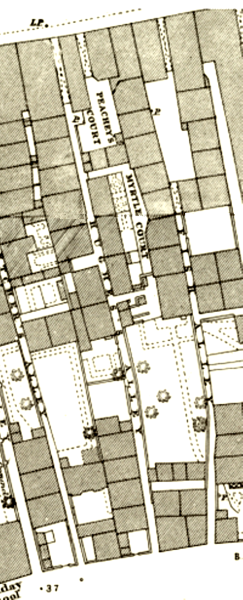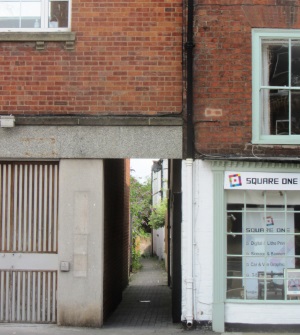Hughe's Alley

Hughes Alley runs between Barton Street and Swilgate Road, one of a number of surviving alleys in that area. It hasn’t survived unscathed, though, because like so many of its neighbours it contained dwellings which were unfit for habitation which were cleared and demolished as Tewkesbury dealt with its housing problems. The Alley was unusual in having houses on both sides and giving access to Myrtle and Peachey’s courts. Altogether, the alley and courts once contained twenty-one dwellings.
The alley is named for Joe Hughes, who was a dairyman. He kept cows in a meadow on Perry Hill and sold milk and butter from his shop at the front of the alley. John Rogers, who wrote about the alleys in 1905, described him as a Quaker of the old sort. His meadow contained a large elm tree beneath which both George Whitfield and John Wesley were said to have preached. This is commemorated in Lezli Lawrence’s artwork at the entrance to the alley.
The Alley Historian himself, John Rogers, opened his ironworking business in the front shop in 1850. He was a remarkable man. Born in Tewkesbury in 1808, he was apprenticed as a whitesmith and bell-hanger then travelled all over England as a journeyman before settling in his home town, where he stayed until his death in 1909, soon after celebrating his centenary. He was responsible for the ironwork around the Crimean gun in Cheltenham and both the Tewkesbury and Gloucester cemetery gates, His name can be seen much closer to home, though, on a cellar cover in Barton Street.
Life in these alleys was generally peaceful and, as John Rogers would say, respectable. People were poor. By far the commonest occupation was labourer, with some people, widows especially, categorised as pauper. The alleys also accommodated a lot of people in boot and shoe making trades, some framework knitters, basket makers, a tanner and even a nailor.
to Expand
Sudden death was much more prevalent than today. Charles Smith, a habitual drunkard, fell down William Hemming’s stairs and broke his neck. Fanny Hawkins, three years old, was engulfed in flames when her clothes caught fire and died at home several days later, Agnes Heath drowned in the Swilgate whilst in a state of deep depression. Charles Cole, 28, father of four children, was suffocated when the sides of a trench he was digging collapsed. The Great War also brought a great deal of news of death, of husbands, sons and brothers.
There were occasional serial miscreants. In 1885, Alfred Newman, basket maker, was convicted of being drunk and disorderly for the nineteenth time. He was apprehended whilst threatening to murder his wife. This was an exception, though, in a generally well-behaved alley.
Hughes Alley suffered the problems of other alleys, of overcrowding and poor sanitation. In 1899, owners agreed to a piped water supply, and in 1902 five cottages were advertised for sale ‘with town water laid on’. There were none of the well contamination problems experienced by other alleys, though.
Occasionally, the tensions of living cheek by jowl led to explosions of anger, as in 1931, when Harry Barker was bound over to keep the peace after an alleged assault on Ethel Bourton, who claimed that he attempted to choke her and then threw a bucket of water over her. The cause of the quarrel was Mrs Bourton’s annoyance with Barker’s son playing in the communal wash-house. Little things get magnified.
By 1931, the Council had Hughes Alley in their sights for clearance and in 1935 it proposed demolition orders on four houses. Only one was demolished, though; the others were recommended for ‘reconditioning’. One was amalgamated with the neighbouring house in Swilgate road. Despite efforts, no solution was found for the other two, which were demolished in 1938. The houses in Myrtle Court, with their little front gardens, disappeared and in 1968 Peachey Court and all the adjacent property in Hughes Alley was replaced by the very discordant National Westminster Bank building, which has now closed and is being converted to offices and housing, retaining the security fencing and concrete yard, unfortunately.
The alley today can best be described as needing improvement. The paving is concrete bricks, with patches of tarmac. Only two houses remain, the rest have been replaced by walls and fences. A redevelopment at the Swilgate Road end, where once there was a hessian bag-making workshop, stopped in 2007 and has become an eyesore embroiled in flood regulation problems.
The Alley remains, though, and in time maybe some of the lost ‘character’ will be restored.Census Data 1841-1891
- Transcribers Note: Enumerator May Have Omitted This From Schedule As Hughes Alley Is Between Schedule 101 And 109
- Mitton?Is this an error? Problem as 58 year old Mary Young is supposed to be dead and that Peter a widower has re-married Mary Ann Hawkley - did she die in June quarter 1851?Marriage: Tewkesbury 11 595 Jun 1850: Young Peter + HAWKLEY Mary Ann ? FREEBMD;
- Elizabeth Cleal, age 71 years of Bleach Yard, Tewkesbury TREG: 04/04/1903
- John Ashley. Swilgate died age 55 (TREG 07/09/1878)
- Marriages Dec 1857 Tewkesbury 6a 842: John Ashley + Ann Soley [Ann Soaley]
- Lodger Listed As Schedule no 104a
- See Schedule no104
- email from Brenda Yoxall byoxall@ihug.co.nz: Fanny PARKER married John junior (John William RICE ) and they were my great grandparents. Fanny died in 1957 and Tewkesbury library have an article written about her when she turned 95 years old in 1955 which they kindly supplied to me.




Comments